1997 GMC SIERRA clutch
[x] Cancel search: clutchPage 238 of 436
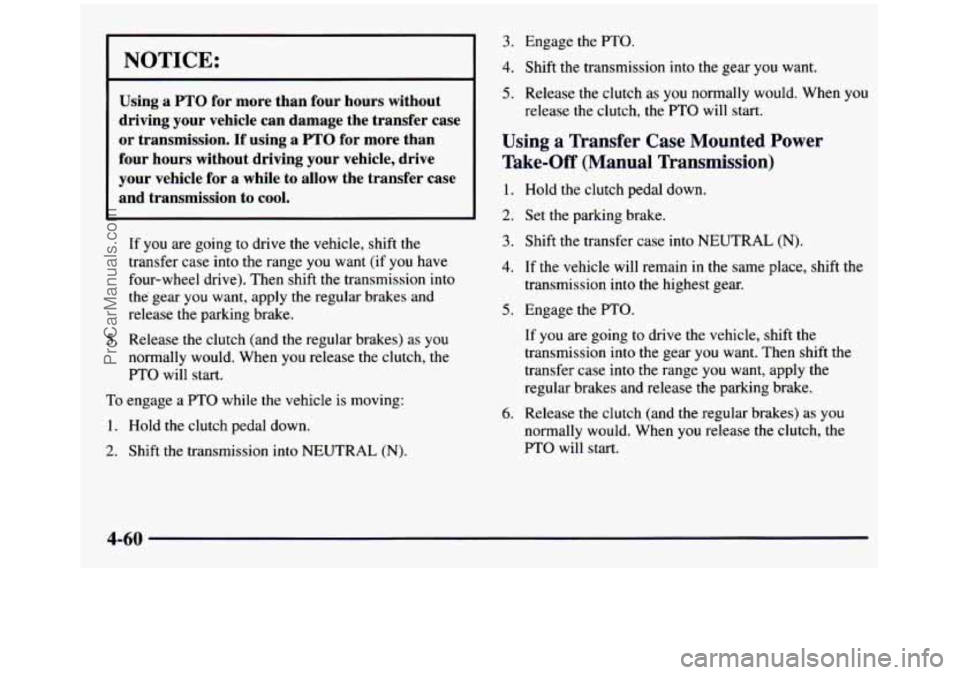
NOTICE:
Using a PTO for more than four hours without
driving your vehicle can damage the transfer case
or transmission. If using a
PTO for more than
four hours without driving your vehicle, drive your vehicle for a while
to allow the transfer case
and transmission
to cool.
If you are going to drive the vehicle, shift the
transfer case into the range you want (if
you have
four-wheel drive). Then shift the transmission into
the' gear you want, apply the regular brakes and
release the parking brake.
5. Release the clutch (and the regular brakes) as you
normally would. When you release the clutch, the
PTO will start.
To engage a PTO while the vehicle is moving:
1. Hold the clutch pedal down.
2. Shift the transmission into NEUTRAL (N).
3. Engage the PTO.
4. Shift the transmission into the gear you want.
5. Release the clutch as you normally would. When you
release the clutch, the PTO will start.
Using a Transfer Case Mounted Power
Take-Off (Manual Transmission)
1.
2.
3.
4.
5.
6.
Hold the clutch pedal down.
Set the parking brake.
Shift the transfer case into NEUTRAL
(N).
If the vehicle will remain in the same place, shift the
transmission into the highest gear.
Engage
the PTO.
If you are going to drive the vehicle, shift the
transmission into the gear you want. Then shift the
transfer case into
the range you want, apply the
regular brakes and release
the parking brake.
Release the clutch (and the regular brakes) as you
normally would. When you release
the clutch, the
PTO will start.
4-60
ProCarManuals.com
Page 261 of 436
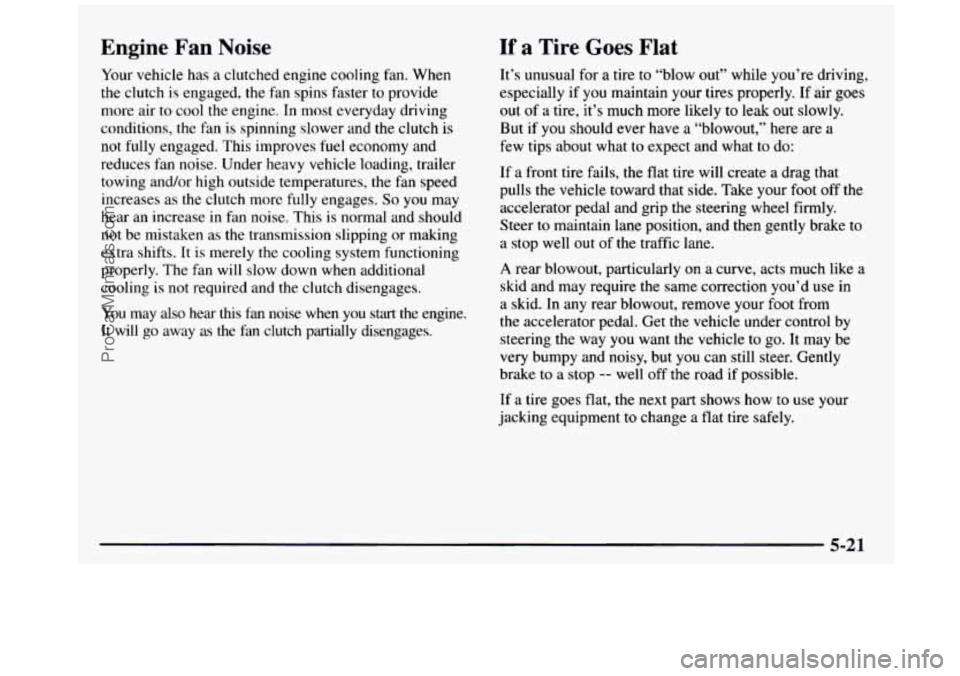
Engine Fan Noise
Your vehicle has a clutched engine cooling fan. When
the clutch is engaged, the fan spi.ns faster to provide
more air
to cool the engine. In most everyday driving
conditions, the fan is spinning slower and the clutch is
not fully engaged. This improves
fuel economy and
reduces fan noise. Under heavy vehicle loading, trailer towing and/or high outside temperatures, the fan speed
increases as the clutch more fully engages.
So you may
hear an increase in fan noise. This
is normal and should
not be mistaken as the transmission slipping or making
extra shifts. It is merely the cooling system functioning
properly. The fan will slow down when additional
cooling is not required and the clutch disengages.
You may also hear this
fan noise when you start the engine.
It will
go away as the fan clutch partially disengages.
If a Tire Goes Flat
It’s unusual for a tire to “blow out” while you’re driving,
especially
if you maintain your tires properly. If air goes
out
of a tire, it’s much more likely to leak out slowly.
But if you should ever have
a “blowout,” here are a
few tips about what to expect and what to do:
If a front tire fails, the flat tire will create a drag that
pulls the vehicle toward that side. Take your foot off the
accelerator pedal and grip the steering wheel firmly.
Steer to maintain lane position, and then gently brake to
a stop well out of the traffic lane.
A rear blowout, particularly on a curve, acts much like a
skid and may require the same correction you’d use in
a skid. In any rear blowout, remove your foot from
the accelerator pedal. Get the vehicle under control by
steering the way you want the vehicle to go. It may be
very bumpy and noisy, but
you can still steer. Gently
brake
to a stop -- well off the road if possible.
If a tire goes flat, the next part shows how to
use your
jacking equipment
to change a flat tire safely.
ProCarManuals.com
Page 277 of 436
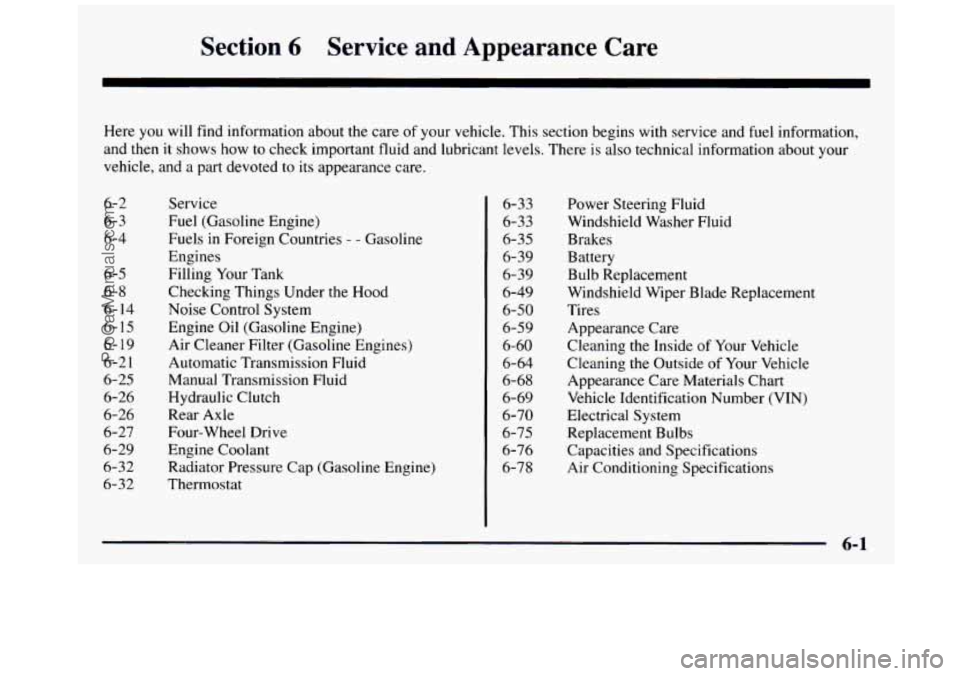
Section 6 Service and Appearance Care
Here you will find information about the care of your vehicle. This section begins with service and fuel information,
and then it shows how
to check important fluid and lubricant levels. There is also technical information about your
vehicle, and a part devoted to its appearance care.
6-2
6-
3
6-4
6-5
6-8
6- 14
6- 15
6- 19
6-2 1
6-25
6-26
6-26 6-27
6-29
6-32
6-32 Service
Fuel (Gasoline Engine)
Fuels
in Foreign Countries - - Gasoline
Engines
Filling Your Tank
Checking Things Under the Hood
Noise Control System
Engine Oil (Gasoline Engine)
Air Cleaner Filter (Gasoline Engines)
Automatic Transmission Fluid
Manual Transmission Fluid
Hydraulic Clutch
Rear Axle
Four-wheel Drive
Engine Coolant Radiator Pressure Cap (Gasoline Engine)
Thermostat 6-33
6-33 6-35
6-39
6-39
6-49 6-50
6-59
6-60
6-64
6-68
6-69
6-70 6-75
6-76
6-78 Power Steering Fluid
Windshield Washer Fluid
Brakes
Battery
Bulb Replacement
Windshield Wiper Blade
R
Tires
Appearance Care .eplacement
Cleaning the Inside
of Your Vehicle
Cleaning
the Outside of Your Vehicle
Appearance Care Materials
Chart
Vehicle Identification Number (VIN)
Electrical System Replacement Bulbs
Capacities and Specifications
Air Conditioning Specifications
ProCarManuals.com
Page 290 of 436
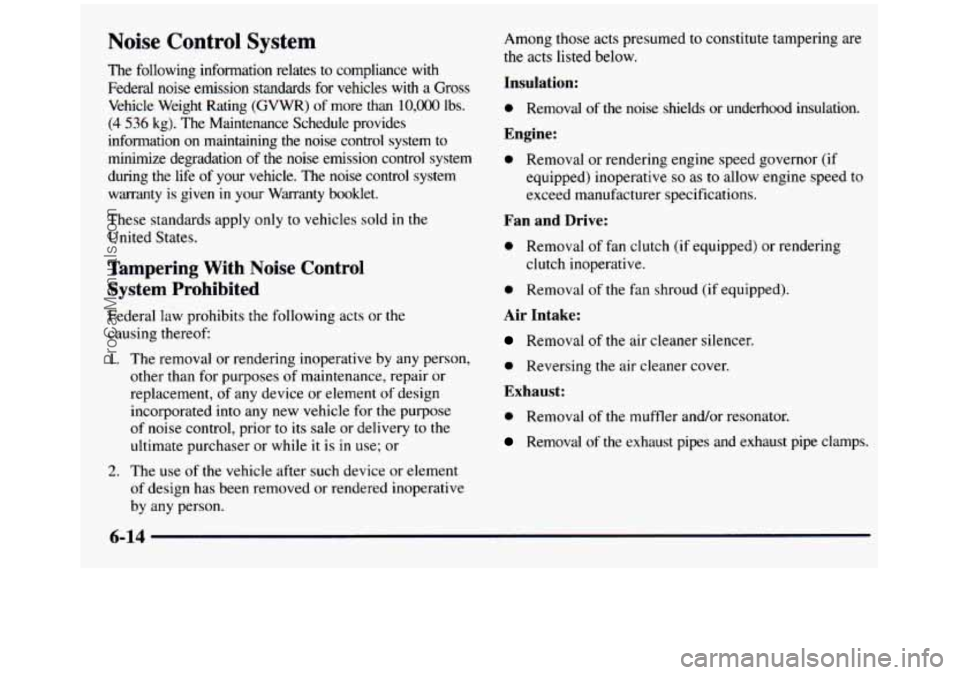
Noise Control System
The following information relates to compliance with Federal noise emission standards
for vehicles with a Gross
Vehicle Weight Rating (GVWR) of more than
10,OOO lbs.
(4 536 kg). The Maintenance Schedule provides
information
on maintaining the noise control system to
minimize degradation of the noise emission control system
during the life of your vehicle. The noise control system
warranty is given in your Warranty booklet.
These standards apply only to vehicles sold
in the
United States.
Tampering With Noise Control
System Prohibited
Federal law prohibits the following acts or the
causing thereof:
I. The removal or rendering inoperative by any person,
other than for purposes of maintenance, repair or
replacement,
of any device or element of design
incorporated into any new vehicle for
the purpose
of noise control, prior to its sale or delivery
to the
ultimate purchaser or while it is in use; or
2. The use of the vehicle after such device or element
of design has
been removed or rendered inoperative
by any person. Among those
acts presumed
to constitute tampering are
the acts listed below.
Insulation:
0 Removal of the noise shields or underhood insulation.
Engine:
0 Removal or rendering engine speed governor (if
equipped) inoperative
so as to allow engine speed to
exceed manufacturer specifications.
Fan and Drive:
0 Removal of fan clutch (if equipped) or rendering
clutch inoperative.
0 Removal of the fan shroud (if equipped).
Air Intake:
Removal of the air cleaner silencer.
0 Reversing the air cleaner cover.
Exhaust:
0 Removal of the muffler and/or resonator.
Removal of the exhaust pipes and exhaust pipe clamps.
ProCarManuals.com
Page 302 of 436
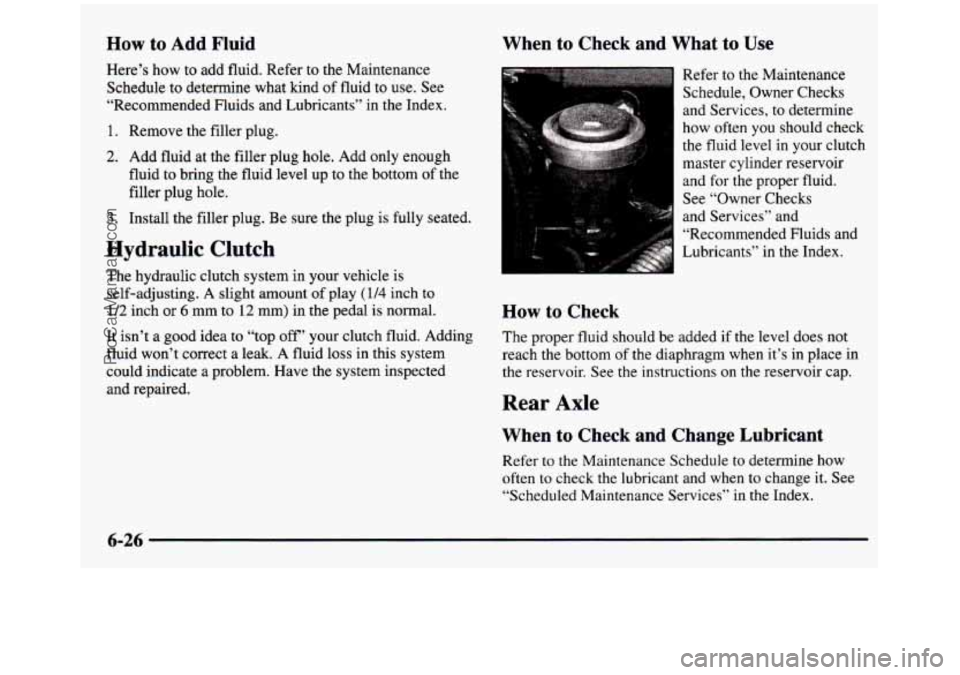
How to Add Fluid When to Check and What to Use
Here’s how to add
fluid. Refer to the Maintenance
Schedule to determine what kind of fluid to use. See
“Recommended Fluids and Lubricants” in the Index.
1. Remove the filler plug.
2. Add fluid at the filler plug hole. Add only enough
fluid to bring the fluid level
up to the bottom of the
filler plug hole.
3. Install the filler plug. Be sure the plug is fully seated.
Hydraulic Clutch
The hydraulic clutch system in your vehicle is
self-adjusting.
A slight amount of play (114 inch to
1/2 inch or 6 mm to 12 mm) in the pedal is normal.
It isn’t
a good idea to “top off’ your clutch fluid. Adding
fluid won’t correct
a leak. A fluid loss in this system
could indicate a problem. Have the system inspected
and repaired. Refer
to the Maintenance
yk I Schedule, Owner Checks
and
Services,
to determine
how often you should check
the fluid level in your clutch
master cylinder reservoir
and for the proper fluid.
See “Owner Checks
and Services” and “Recommended Fluids and
Lubricants” in the Index.
How to Check
The proper fluid should be added if the level does not
reach the bottom of the diaphragm when it’s in place in
the reservoir. See the instructions on the reservoir cap.
Rear Axle
When to Check and Change Lubricant
Refer to the Maintenance Schedule to determine how
often
to check the lubricant and when to change it. See
“Scheduled Maintenance Services” in
the Index.
6-26
ProCarManuals.com
Page 400 of 436
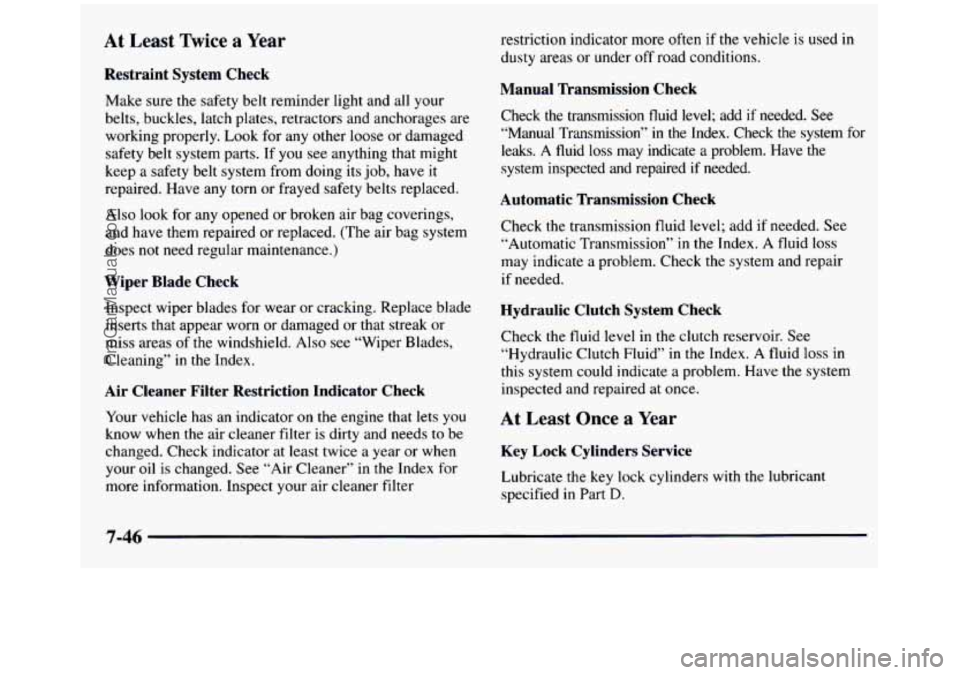
At Least Twice a Year
Restraint System Check
Make sure the safety belt reminder light and all your
belts, buckles,
latch plates, retractors and anchorages are
working properly. Look for any other loose or damaged
safety belt system
parts. If you see anything that might
keep a safety belt system from doing its job, have it
repaired. Have any torn or frayed safety belts replaced.
Also look for any opened or broken air bag coverings,
and have them repaired or replaced. (The air bag system
does
not need regular maintenance.)
Wiper Blade Check
Inspect wiper blades for wear or cracking. Replace blade
inserts that appear worn or damaged or that streak or
miss areas of the windshield. Also see “Wiper Blades,
Cleaning” in the Index.
Air Cleaner Filter Restriction Indicator Check
Your vehicle has an indicator on the engine that lets you
know when the air cleaner filter is dirty and needs
to be
changed. Check indicator at least twice a year or when
your oil is changed. See “Air Cleaner” in
the Index for
more information. Inspect your air cleaner filter restriction indicator more often
if the vehicle is used in
dusty areas or under off road conditions.
Manual Transmission Check
Check the transmission fluid level; add if needed. See
“Manual Transmission” in
the Index. Check the system for
leaks. A fluid loss may indicate a problem. Have the
system inspected and repaired if needed.
Automatic Transmission Check
Check the transmission fluid level; add if needed. See
“Automatic Transmission” in the Index.
A fluid loss
may indicate a problem. Check the system and repair
if needed.
Hydraulic Clutch System Check
Check the fluid level in the clutch reservoir. See
“Hydraulic Clutch Fluid” in the Index. A fluid loss in
this system could indicate a problem. Have the system
inspected and repaired
at once.
At Least Once a Year
Key Lock Cylinders Service
Lubricate the key lock cylinders with the lubricant
specified
in Part D.
7-46
ProCarManuals.com
Page 401 of 436

Body Lubrication Service
Lubricate all fuel doors, body hood and body door
hinges, tailgate and tailgate handle pivot points, latches,
locks and folding seat hardware. Part
D tells you what to
use. More frequent lubrication may be required when
exposed
to a corrosive environment.
Starter Switch Check
’ A CAUTION:
When you are doing this check, the vehicle could
move suddenly.
If it does, you or others could be
injured. Follow the steps below.
3. On automatic transmission vehicles, try to start the
engine
in each gear. The starter should work only in
PARK (P) or NEUTRAL (N). If the starter works in
any other position, your vehicle needs service.
On manual transmission vehicles, put
the shift lever
in NEUTRAL (N), push the clutch down halfway
and try
to start the engine. The starter should work
only when the clutch
is pushed down all the way to
the floor. If the starter works when the clutch isn’t
pushed all the way down, your vehicle needs service.
1. Before you start, be sure you have enough room
2. Firmly apply both the parking brake (see “Parking
around the vehicle.
Brake” in
the Index if necessary) and the
regular brake.
NOTE: Do not use the accelerator pedal, and be
ready
to turn off the engine immediately if it starts.
Brake-’Ikansmission Shift Interlock (BTSI) Check
(Automatic Transmission)
I A CAUTION:
When you are doing this check, the vehicle could
move suddenly. If it does,
you or others could be
injured. Follow the steps below.
1. Before you start, be sure you have enough room
around the vehicle. It should be parked on a
level surface.
7-47
ProCarManuals.com
Page 405 of 436
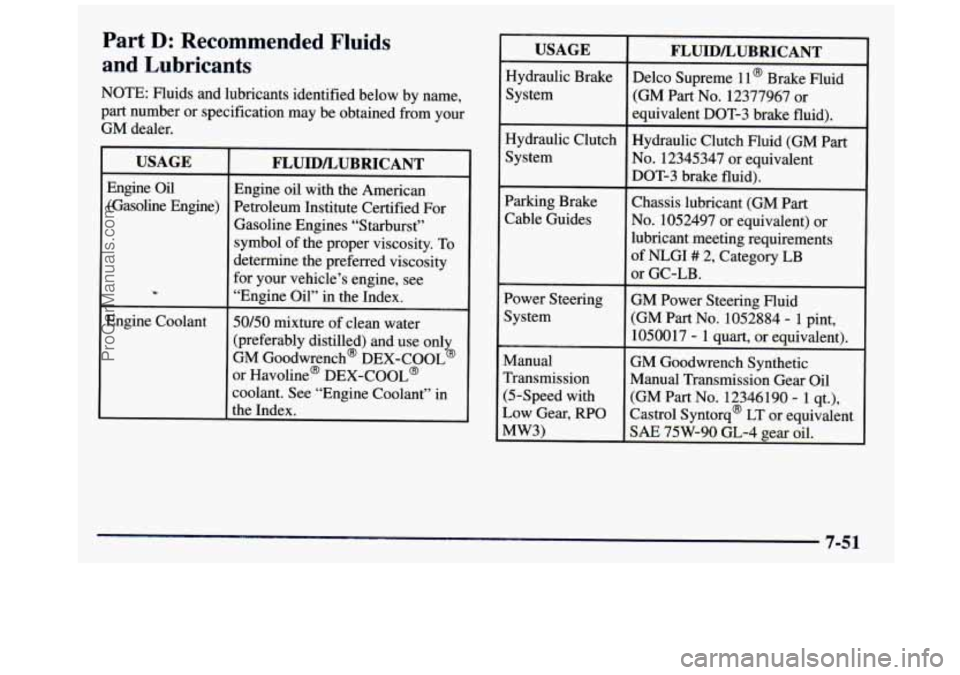
Part D: Recommended Fluids
and Lubricants
NOTE: Fluids and lubricants identified below by name,
part number or specification may be obtained from your
GM dealer.
USAGE
Engine Oil (Gasoline Engine)
’*
Engine Coolant
~
FLUIDLUBRICANT
Engine oil with the American
Petroleum Institute Certified For
Gasoline Engines “Starburst”
symbol of the proper viscosity. To
determine the preferred viscosity
for your vehicle’s engine, see
“Engine Oil” in the Index.
~
50150 mixture of clean water
(preferably distilled) and use only
GM Goodwrench’ DEX-COOL@
or Havoline@ DEX-COOL@
coolant. See “Engine Coolant” in
the Index.
USAGE
Hydraulic Brake
System
~
Hydraulic Clutch
System
Parking Brake
Cable Guides
Power Steering
System
Manual
Transmission
(5-Speed with
Low Gear,
RPO
MW3)
FLUIDLUBRICANT
Delco Supreme 11 ’ Brake Fluid
(GM Part
No. 12377967 or
equivalent DOT-3 brake fluid).
Hydraulic Clutch Fluid (GM Part
No. 12345347 or equivalent
DOT-3 brake fluid).
Chassis lubricant (GM Part
No. 1052497 or equivalent) or
lubricant meeting requirements
of NLGI
# 2, Category LB
or GC-LB.
GM Power Steering Fluid
(GM Part No. 1052884
- 1 pint,
10500 17
- 1 quart, or equivalent).
GM Goodwrench Synthetic
Manual Transmission Gear Oil
Castrol syntorq’
LT or equivalent
SAE 75W-90 GL-4 gear oil.
(GM
Part NO. 12346190 - 1 st.),
7-51
ProCarManuals.com